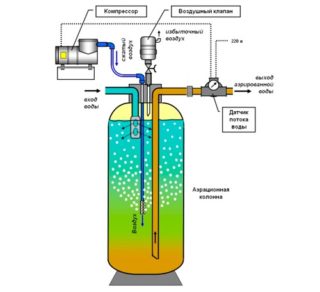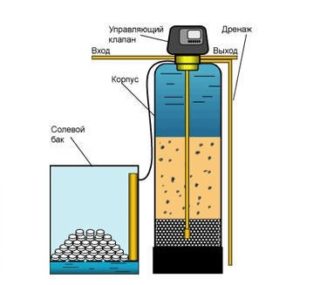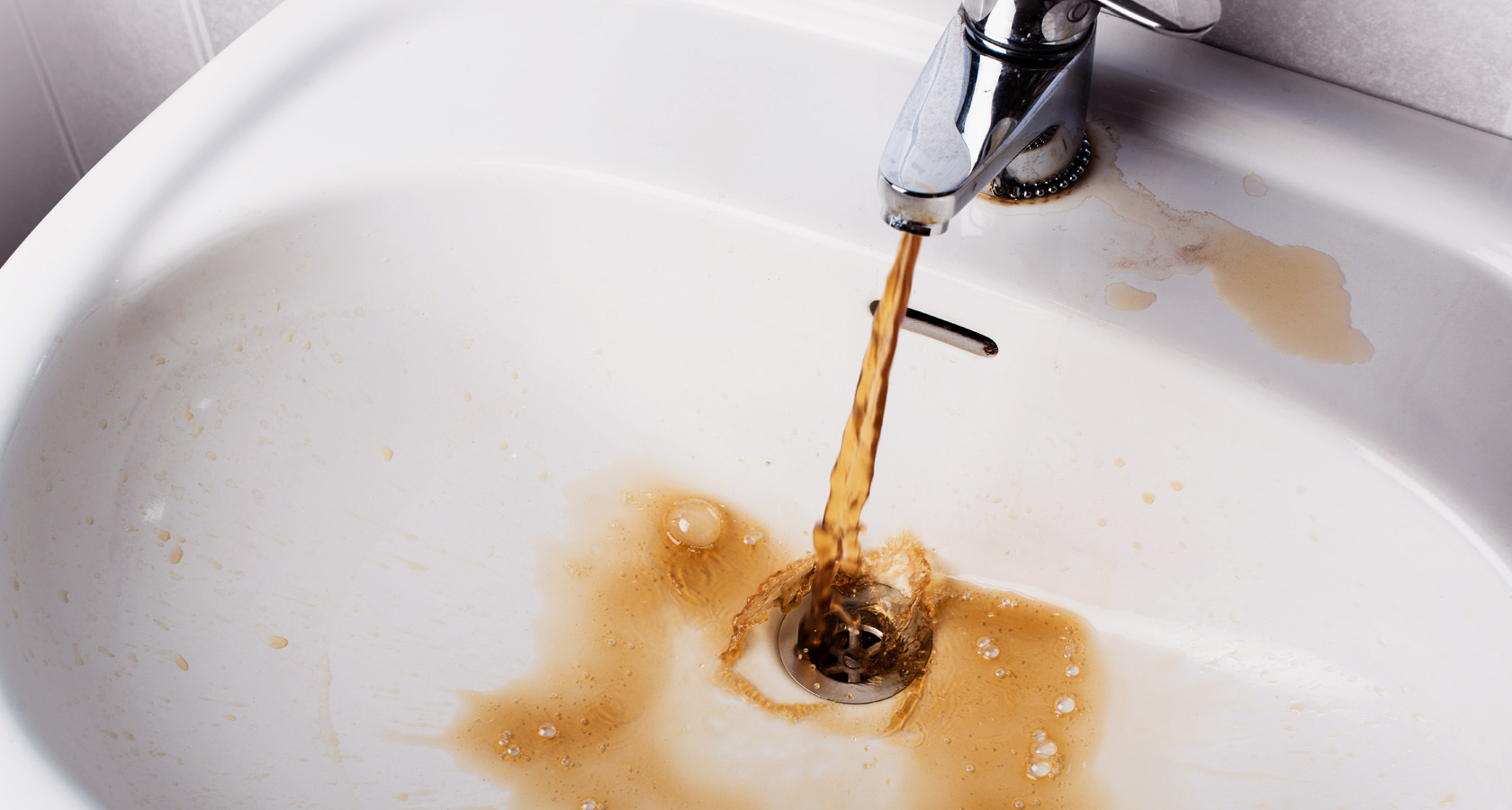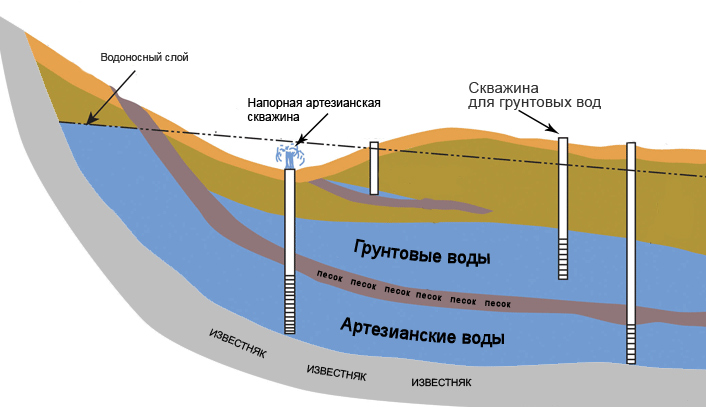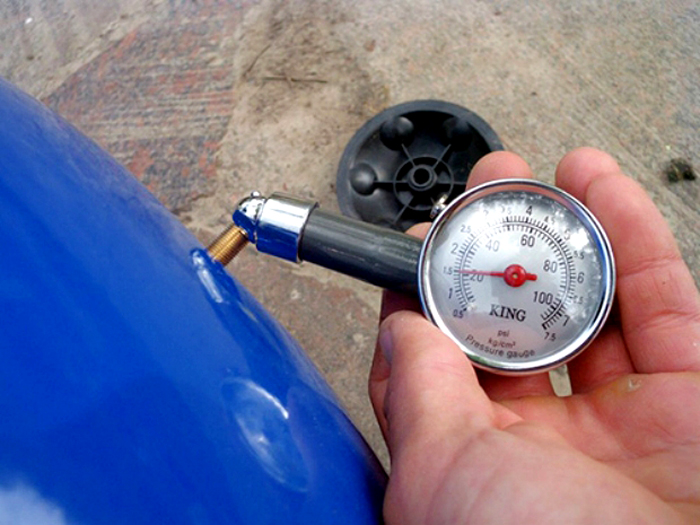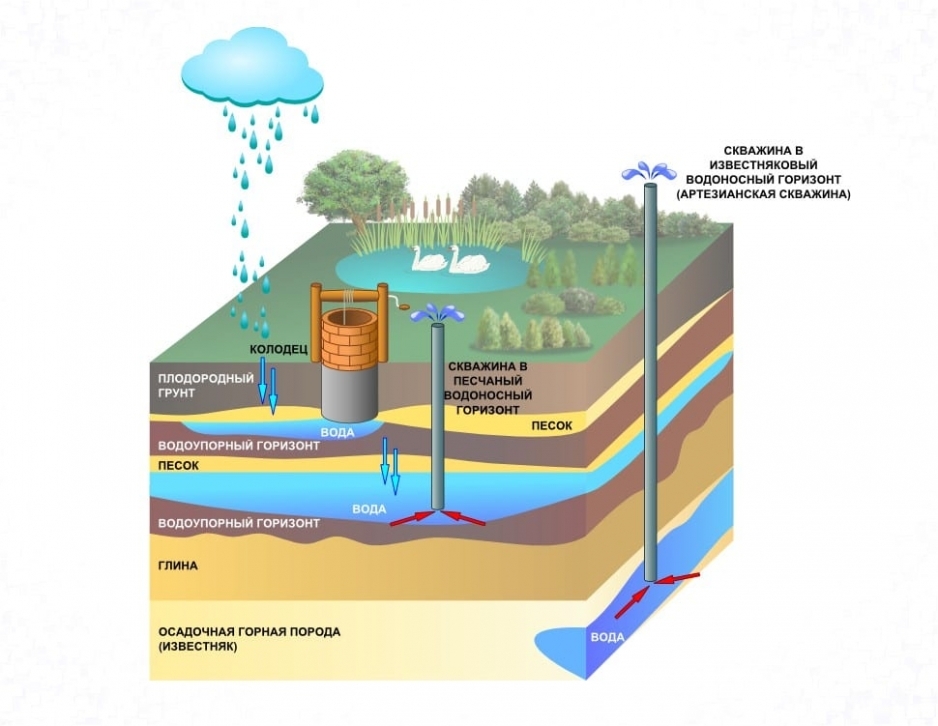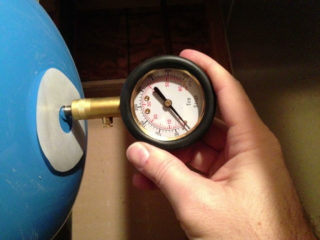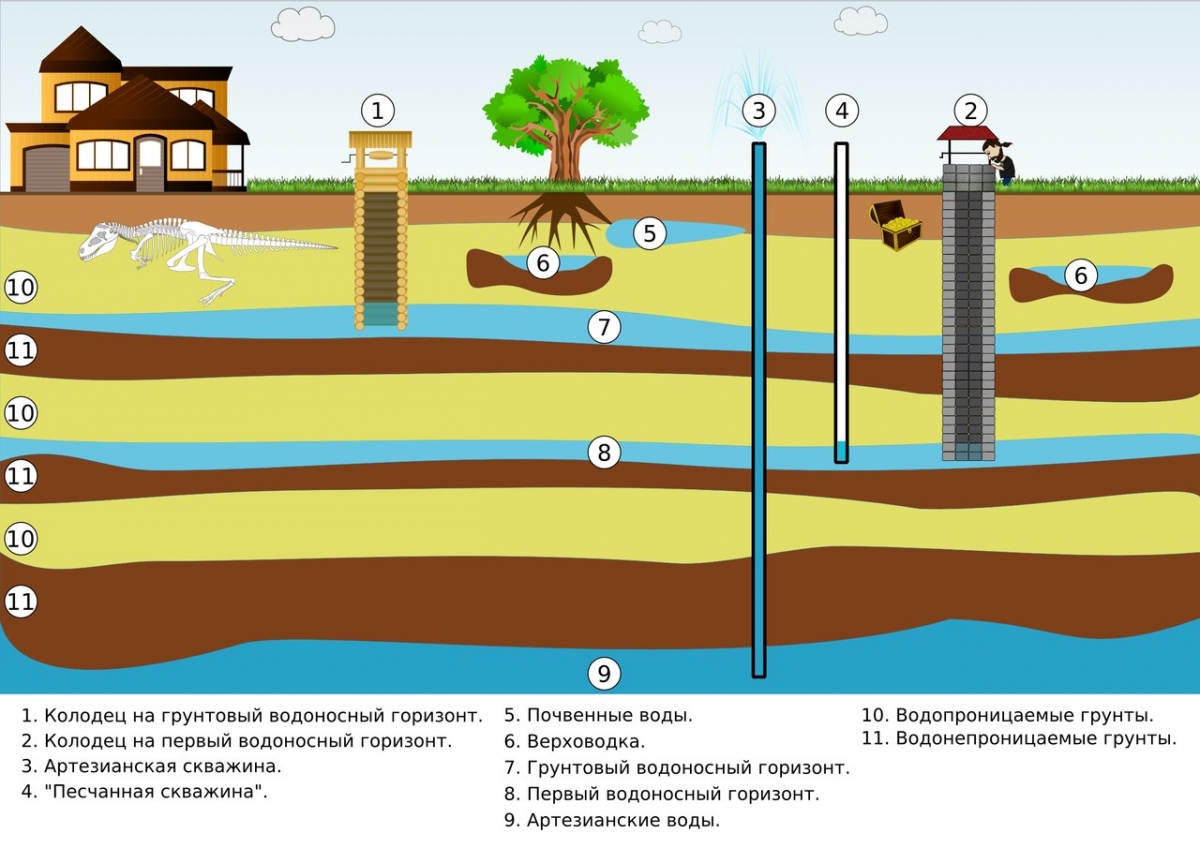Water from a well or well is not ideal: it contains various impurities and bacteria. Sometimes they can harm health, cause inconvenience with an unpleasant smell and taste. In order for the life-giving moisture to become clean, tasty and safe, you will need a system for high-quality water purification from a well for a private house.
The need for well water purification
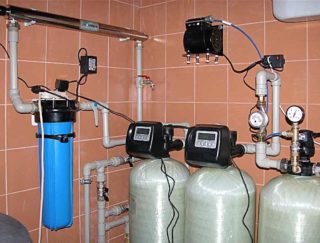
Due to climatic and geological features, large volumes of dissolved iron, hardness salts, chlorine, magnesium get into the subsoil waters, which are able to penetrate into the well through microcracks in the casing, with precipitation or as a result of overflows due to floods.
If the borehole is shallow, there is a risk of contamination of the fluid with nitrates, pesticides, pathogenic microorganisms.
In deep artesian wells, the water is cleaner. But even there there is a danger of the penetration of hydrogen sulfide compounds and salts of heavy metals from tightly plugged layers.
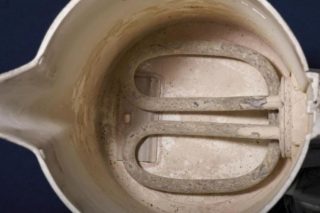
Rusty stains and scale are formed on plumbing fixtures and household appliances due to water suspensions, which causes aesthetic damage and leads to breakdown of devices. Most of the impurities are not fatal, but if they enter the source of liquid from the upper water, infection with pathogenic microorganisms that cause intestinal diseases is possible. Nitrates in the water from the well are also dangerous, which can provoke anemia and malignant formations. Hydrogen sulfide is harmful - it can cause serious poisoning.
Most often, pollution occurs due to such factors:
- close proximity of the well with a country toilet, septic tank, bathhouse, cesspool or cemetery;
- drainage of household chemicals into the ground;
- overestimated concentration of fertilizers for the garden and vegetable garden.
To obtain clean drinking water, it will be necessary to install equipment for cleaning the liquid from the well from bacteria, iron and hydrogen sulfide, as well as softeners and sorption filters.
The main ways to purify water
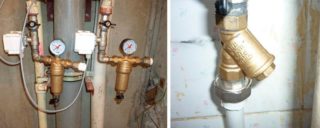
Depending on the type of pollutants, a method for cleaning the liquid is selected. Their concentration can be found out by examining samples in laboratory conditions. Water treatment of a private house is performed in four purification stages:
- Rough. Large impurities - sand, silt, dirt - are captured using mesh or bulk filtration devices.
- Chemical. Suspensions of iron, calcium, manganese and hydrogen sulfide are removed, water softening is carried out. For this, columns of aeration and deferrization are used.
- Biological. Under the influence of ultraviolet radiation or ozone, water is disinfected from pathogenic microbes.
- Thin. The maximum purification is carried out by means of ion exchange devices.
The last two stages are combined in environmentally friendly reverse osmosis machines. However, in this case, you will have to install a mineralizer, since the liquid becomes distilled and useless for drinking.
If there is a lot of silt and organic impurities in the water, you can clean it yourself. Citric acid will come to the rescue. It is necessary to fill several packs of powder into the well shaft and wait a few days, and then pump the well.Filters will be cleaned simultaneously with disinfection, and the flow rate of the hydraulic structure will be restored.
If the folk remedy does not help, you should seek professional help. Experts will carry out high-quality cleaning of the mine, recommend suitable filters and even install them on a turnkey basis.
Cleaning systems
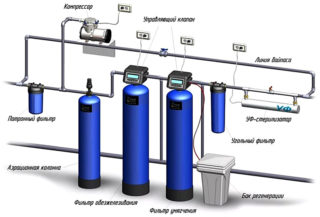
Well water filtration facilities perform the following functions:
- Preliminary purification, which involves the removal of coarse-fraction impurities from the liquid. For these purposes, mechanical mesh filter elements are usually used. Depending on the size of the cell, the cross section of the captured fractions is also determined. But sometimes gravel options are also used. As a result, this makes it possible to reduce the wear of equipment, including installations for fine water purification.
- Adsorption with the elimination of hazardous components, as well as the unpleasant taste and odor of the liquid. The best filler is activated carbon due to its microscopic pores. It is poured into special cartridges that must be replaced at regular intervals. They function as sorption filters and filters with membranes.
- Softening with trapping of hardness salts, lime, iron. Devices for deferrization and softening of water operate due to chemical reagents or on the principle of oxidation of metal impurities that precipitate and are retained by the filtration element. In addition to purifying water from a well or well in a country house to drinking water, installations are used to protect household appliances from scale and rust.
- Biological purification to remove pathogens. Most often, ultraviolet cleaners act as "antibiotics". They are easy to operate and pose no danger to people and animals. Ultraviolet light destroys pathogenic bacteria, viral agents, protozoa, fungi.
To immediately purify and soften water, ion-exchange units are used. They are divided into two types: hydrogen and sodium. Heavy metal salts, traces of radionuclides, as well as harmful nitrates and nitrites pass through purification devices and are converted into harmless compounds.
The best purification is provided by reverse osmosis columns equipped with nanomembranes that allow only water molecules to pass through. But the liquid at the outlet is practically distilled, for drinking it must be mineralized. Such installations are often used for industrial purposes if the industry requires high purity of the raw materials used.
Choosing the right cleaning device

In order for a well water filtration system to suit you, you need to consider the following criteria:
- Qualitative characteristics of the liquid. To find out the types and concentrations of harmful impurities, a sample is analyzed in the laboratory. If there is an excess of coarse suspended solids in the water, a 400 micron coarse filter mesh is required. The use of filters with smaller sizes does not make sense - they will instantly become unusable.
- The volume of water consumption. A person needs 2.5 liters of liquid per day. To calculate the potential expense, the figure must be multiplied by the total number of people living in the house.
- Equipment dimensions. The technological indicator is proportional to the productivity of the station. When building a new house, it is imperative to take into account where the filtration module will be located, especially if the installation of an overall treatment plant is planned. If the installation will be carried out in an old building, it is worth considering the possibility of a small layout so that the residents are comfortable.
- Availability of automation. The filtration device has two modes of action - working and regenerative to restore the contents of the cartridges. If the system is not equipped with an automatic switching unit, you will have to do everything manually.Such options are cheaper, but equipment equipped with a special control valve is much more convenient to operate.
You should also take into account the costs of purchasing the station itself, its installation and the subsequent costs of cartridges and other components.
The preferred option for a water supply system from a well

For a home with permanent residence, the water supply of which is carried out from a well, it is wiser to assemble a filtering system from the following nodes:
- block for coarse mechanical cleaning to remove coarse-fraction impurities;
- ultraviolet disinfection device;
- sorption device based on activated carbon for discoloration of liquid, removal of stench and unpleasant taste, turbidity and micro-fragments of organic matter;
- main electromagnetic softener;
- fine filter.
This is optional, but the preferred scheme. The total number of nodes is determined according to the individual qualities of the water. It is mandatory to install only a coarse filter.

The system is installed in the following sequence:
- An additional segment is cut into the outlet pipe, to which all of the above nodes are connected.
- At the place of the tie-in, a bypass is installed so that the liquid can be sent to the treatment network or disconnected during repairs or preventive maintenance.
- Additionally, all filters are connected by hoses with a drain valve at the end of the chain, to make it easier to flush from contamination.
If we talk about the price of a water treatment system, for example, an aeration column assembly 1054 costs from 8,000 rubles, depending on the manufacturer. If you buy a coarse filter for it, for a well that is not in a polluted place, this should be enough. At the dacha, you can choose a budget option at all for 1500-3000 rubles with ion-exchange filters, or a simple cheap cartridge for 400 rubles. These can be bought in any retail network, for example, "Leroy Merlin".
The cost of the water treatment complex varies from 20,000 to 600,000 rubles. For example, the Russian stations "Aquaphor" with integrated treatment and aeration unit cost around 130,000 rubles, "Geyser" - 99,000 rubles. Equivalents produced by the USA EcoWater Systems - about 200,000 rubles.

